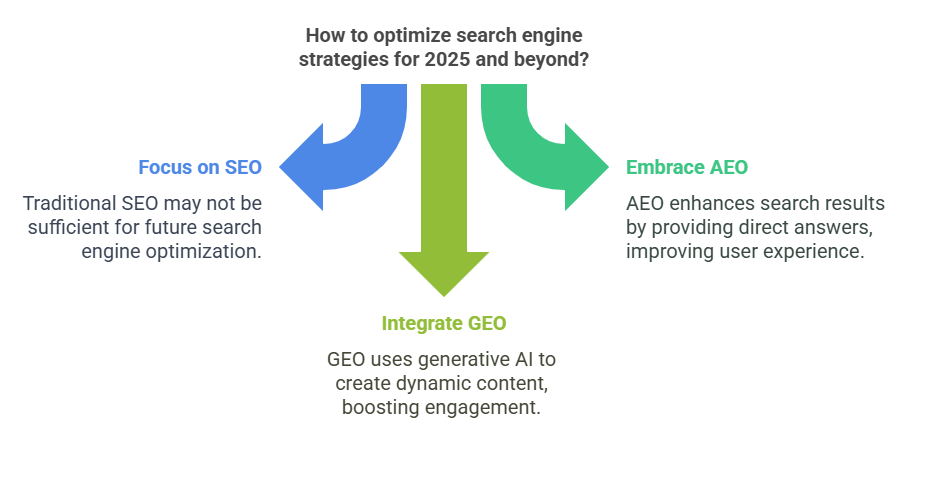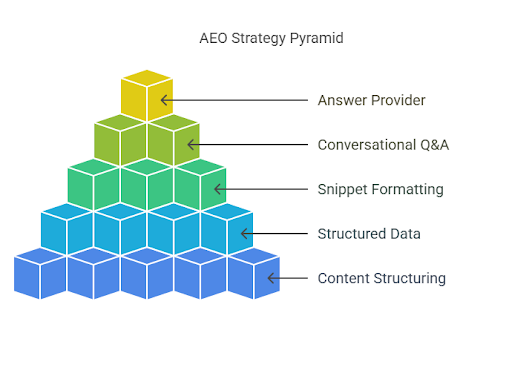SEO Is No Longer Enough: The Rise of AEO and GEO
“If you’re not optimizing for how AI finds and displays your content — you’re already falling behind.”
Welcome to the age of AEO (Answer Engine Optimization) and GEO (Generative Engine Optimization).
SEO alone won’t cut it in 2025 and beyond.
🌐 What Are SEO, AEO, and GEO?
🔍 SEO (Search Engine Optimization)
This is the traditional method of optimizing websites to rank higher on search engines like Google and Bing. It focuses on:
- Keywords
- Meta tags
- Backlinks
- Technical site health (speed, mobile optimization, etc.)
SEO is about ranking on Google’s SERP (Search Engine Results Page).
💡 AEO (Answer Engine Optimization)
AEO focuses on structuring your content so it can be easily understood and directly answered by AI-powered search engines and virtual assistants like:
- Google Assistant
- Siri
- Alexa
- Bing AI Search
AEO often uses:
- Schema.org structured data
- Featured snippet formatting
- FAQ and How-To sections
- Conversational Q&A structures
AEO is about being the answer — not just a clickable link.
🤖 GEO (Generative Engine Optimization)
GEO is the new frontier: optimizing content for generative AI models like ChatGPT, Claude, Gemini, and Perplexity.
These systems don’t link — they generate responses from what they understand about your content. So, visibility depends on:
- Machine-readable content
- Clear source attribution
- Topical authority and originality
- Human-sounding, fact-rich narratives
GEO is about being included in AI responses — not just found by crawlers.
🔁 How Do They Differ?
| Factor | SEO | AEO | GEO |
|---|---|---|---|
| Goal | Rank high on SERPs | Be featured in direct answers | Be cited or used by AI models |
| Target Platform | Google/Bing/Yahoo | Voice assistants, rich snippets | AI search/chat engines |
| Optimization Format | Keywords, links, structure | Schema markup, Q&A formats | Clean data, context-rich writing |
| Outcome | Clicks | Instant answers | AI citation or summary inclusion |
🛠 Action Plan: How to Future-Proof Your Content Strategy
✅ 1. Use Structured Data (Schema)
- Add JSON-LD markup to all key pages.
- Focus on
FAQ,HowTo,Article, andProductschemas.
✅ 2. Write for Questions
- Include natural-language questions as subheadings (
## How does X work?) - Follow with concise, direct answers.
✅ 3. Create Contextual, Source-Rich Content
- Link to reputable sources.
- Use authoritative language and consistent terminology.
✅ 4. Optimize for Chat and Voice
- Use short, spoken-style sentences.
- Include TL;DR summaries and bullet points.
✅ 5. Track Emerging AI Search Tools
- Monitor platforms like Perplexity, You.com, and ChatGPT Browse.
- Test how your content shows up in these engines.
🧭 Why This Matters
Google’s AI Overviews, Bing’s AI answers, and tools like ChatGPT are reshaping how users find information. If your content isn’t optimized for these systems:
- You risk becoming invisible.
- Even high-ranking pages may not be used or cited by AI.
- Competitors with better-structured content will get more visibility — even without higher traditional SEO rankings.
🤔 Final Thought
Ask yourself:
Am I only chasing Google rankings, or am I preparing for the AI-first internet?
SEO is still important — but AEO and GEO are no longer optional.
Smart marketers are investing in all three.
💬 Let’s Discuss
Which are you focusing on: SEO, AEO, or GEO?
Comment your thoughts and let’s build future-ready content strategies together.






